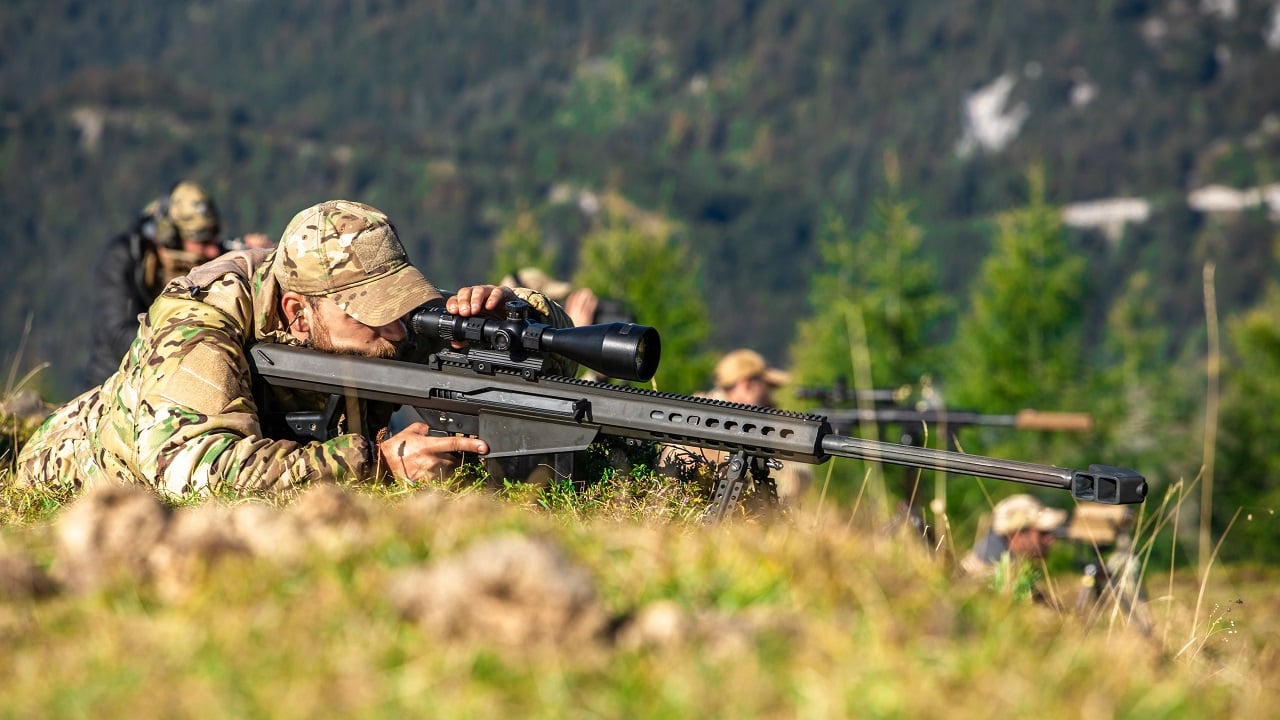The Barrett M82 sniper rifle is a military and firearms legend for countless reasons: Sometimes the military needs a little bit of nudging to determine it actually needs a new weapon. That might just be the short version of the history of the Barrett M82.
The U.S. military has a proven track record of sometimes not seeing the potential, and this was true initially of the machine gun – and more recently with a very high powered sniper rifle.
The concept of large rifles isn’t entirely new. Large caliber “wall guns” had been used since the 16th century in Europe, and remained in use throughout the 18th and 19th century in India and China – where oftentimes two or more men were required to wield the oversized weapons. During the First World War, the German military fielded its Tankgewehr M1918 anti-tank rifle – a 13.2mm bolt action rifle designed to take out enemy tanks.
A generation later the British employed its .55mm Boys anti-tank rifle in a similar role. However, as the thickness of armor increased, these weapons could do little if any significant damage against tanks.
Yet, during the Cold War, Ronnie Barrett considered the ways that a large caliber rifle could be employed. While not exactly a trained gun designer, but rather a professional photographer, Barrett became intrigued with the idea to develop a rifle that could fire the .50 BMG round. In 1982 he launched the Tennessee-based Barrett Firearms and set about creating such a weapon.
How the M82 Was Born
The result was the Barrett M82 sniper rifle, and it was as innovative as it was powerful. The shoulder-fired, semi-automatic rifle was designed around the .50 BMG cartridge, and unique among firearms of the time, the Barrett rifle’s barrel recoiled backward after firing. A rotating-lock breech block equipped with an accelerator arm used part of the recoil energy to push back the block on firing. This cycled the action, cocked the firing pin, and loaded a new round from a ten-round steel magazine.
While it might be easy to assume “if you build it, they will come” – think again.
The Barrett M82 offered a solution to a problem the military really didn’t know it had, which was how to use a rifle that could shoot nearly a thousand yards.
In fact, the U.S. military didn’t immediately see any need for Barrett’s design. However, Barrett did convince the Swedish Army to adopt the weapon, and that was reportedly enough to keep the company afloat.
M82 Goes to War
Then in 1990, the United States military became involved in Operation Desert Shield and while preparing for Operation Desert Storm, the liberation of Kuwait, and the invasion of Iraq, the U.S. Marine Corps acquired 125 of the rifles. Orders from the U.S. Army and U.S. Air Force soon followed.
The M82 was adopted as the SASR – Special Applications and Scoped Rifle – and it proved its worth in Operation Desert Storm. Since then, Barrett has since developed several other models including the M95, M99 and M99-1. The U.S. military has employed the M82 as an “anti-material rifle,” where it is used against small watercraft, radar equipment, missile launchers, and even stationary enemy aircraft.
The recoil-operated, semi-automatic rifle was also developed to accept a suppressor. It has a muzzle velocity of 2,799 feet per second, and an effective range of nearly 2,000 yards (1,800 meters). It is fed from either a five or ten-round detachable box magazine. While the rifle will be phased out with the U.S. military’s adoption of the Barrett MRAD MK22, the M82 will be remembered as an innovative sniper rifle that supersized a sniper’s ability to hit targets at extreme ranges.
There may have been Kentucky and Pennsylvania “long rifles,” but it is easy to see why in 2016, the Barrett M82 even became Tennessee’s “official state rifle.”
Peter Suciu is a Michigan-based writer who has contributed to more than four dozen magazines, newspapers and websites. He regularly writes about military small arms, and is the author of several books on military headgear including A Gallery of Military Headdress, which is available on Amazon.com.

